









Greetings alumni and colleagues,
On behalf of the Engineering School of Infrastructure & Environment (ESSIE), I’m eager to share major updates from this past year.
To begin, Kathe Todd-Brown, Ph.D., an assistant professor in the Department of Environmental Engineering Sciences, received the National Science Foundation’s CAREER award. Through this highly competitive award, Dr. Todd-Brown hopes to improve the predictive understanding of soil carbon dynamics by connecting different theories with diverse measurements.
We are proud that our faculty members continue to strive in prestigious organizations in respect to their fields of research. Denise R. Simmons, Ph.D., an associate professor in the Department of Civil & Coastal Engineering, received the Best Paper Award from the Australasian Journal of Engineering Education. In addition, two of our civil engineering faculty members received awards from the American Concrete Institute (ACI) in March. Christopher Ferraro, Ph.D., P.E., assistant professor, received ACI’s Delmar L. Bloem Distinguished Service Award for his work on technical committees, making him one of three recipients to receive this recognition. Kyle A. Riding, Ph.D., professor, was named an ACI Fellow, making him one of 20 members inducted into this year’s class.
Faculty and students have been focused on mitigating airborne and waterborne diseases. Antarpreet Jutla, Ph.D., an associate professor in the Department of Environmental Engineering Sciences, received $1 million from NASA to study and develop prediction models to forecast cholera, a waterborne infectious disease. His research makes UF the first institution trying to understand patterns of disease emergence in several parts of the world by prediction tools. A study, initiated by William (Brad) Vass, a first-year doctoral student, and Chang-Yu Wu, Ph.D., a professor in the Department of Environmental Engineering Sciences, found that homes might be hotspots to spread the virus that causes COVID-19. They were also the first to demonstrate an infectious virus on the surface of a cellphone.
Speaking of Dr. Wu, it is bittersweet that he will bid farewell to ESSIE after his nearly 25-year tenure. We had the opportunity to see Dr. Wu grow from an assistant professor to a professor and department head. We wish him nothing but success at his new position as department head at the University of Miami.
This year we welcome three new faculty members: Ge ‘Gaby’ Ou, Ph.D., Jane McKee Smith, Ph.D., and Xiang ‘Jacob’ Yan, Ph.D., who are all joining as assistant professors in the Department of
Civil & Coastal Engineering.
The newly established Center for Coastal Solutions (CCS) is continuing to make an impact on coastal communities within Florida. We give an overview of the important studies and partnerships CCS has conducted in the past year, which includes research about human activity intensifying red tide blooms in Southwest Florida to the $3 million funding from the U.S. Army Corps of Engineers (USACE) that will give USACE a sustainable framework for coastal conservation and remedial projects on Florida’s First Coast.
Our staff members continue to contribute to the overall excellence of the school. Sophie Sprately, Ph.D., an academic advisor within the Department of Civil & Coastal Engineering, was named UF Advisor of the Year. It comes as no surprise to us; she has been remarkable throughout her six years in our department. Earlier in January, she received an award from the Herbert Wertheim College of Engineering for Undergraduate Professional Advisor of the Year.
As usual, there is too much to say about the achievements of our students to provide even a short summary. Instead, I will focus on our Eckhoff Steel Bridge Team’s performance in American Institute of Steel Construction’s Student Steel Bridge National Competition. They placed first overall, making them back-to-back champions with only two builders, teams typically have four-tosix builders.
Lastly, we are incredibly proud of our alumni who are recognized for their passion for engineering, the community and ESSIE. Carlos Penin, PE , received UF’s Association of Hispanic Alumni Gran Caimán of the Year award for his service and nearly 40 years of work in civil engineering.
We look forward to ongoing success for our faculty, students and alumni. I continue to wish you and your loved ones’ good health and happiness.
Kirk Hatfield, Ph.D. DIRECTOR, ENGINEERING SCHOOL OF SUSTAINABLE INFRASTRUCTURE & ENVIRONMENT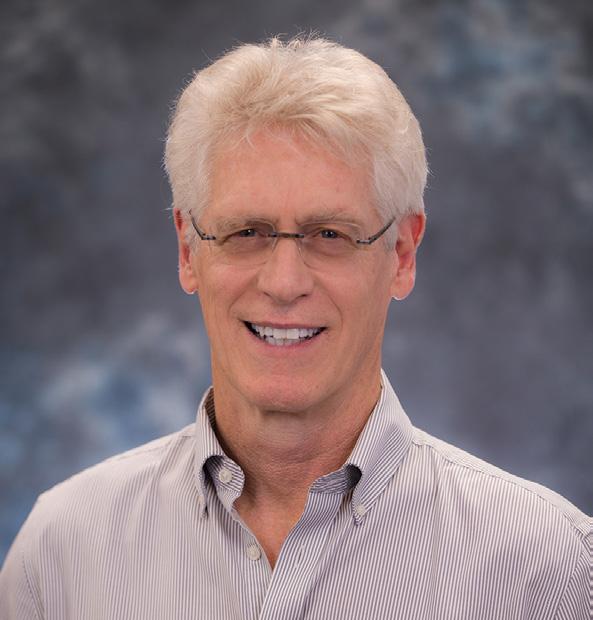
BY BRINGING RESEARCHERS TOGETHER TO TALK ABOUT HOW WE TALK ABOUT DATA, WE CAN BUILD A BETTER UNDERSTANDING OF SOILS AND USE THESE DATA TO DEVELOP BETTER MODELS.
Kathe Todd-Brown, Ph.D., an assistant professor in the Department of Environmental Engineering Sciences, has been awarded the National Science Foundation’s (NSF) CAREER award to improve the predictive understanding of soil carbon dynamics by connecting different theories with diverse measurements.

With a background in computational biogeochemistry, Dr. Todd-Brown will study the decay rate of soil by connecting observed decay trends with the theoretical understanding of the underlying processes through a new multi-scale modeling framework. Currently, soil decay rates are difficult to predict, and this has an impact on how well we can predict atmospheric greenhouse gas levels and set emissions targets. This new research will help improve predictions by linking the decay rates to soil properties processes through a new multi-scale modeling framework.
”Soil impacts our daily lives from food to our ecosystem including atmospheric carbon dioxide, water cycling and nutrient management. Understanding how soils decay, or lose carbon stocks, is critical to understanding the broader carbon cycle and predicting future greenhouse gas levels.
“We’re trying to understand soil decomposition,
so we can better predict climate change feedbacks, and this will also help us understand nutrient and water cycles in managed and natural ecosystems,” Dr. Todd-Brown said. “We’re going to dive into three key processes that we think control soil carbon dynamics: mineralorganic interactions, microbial metabolism and organic chemistry. All three of these processes level off the rate of carbon soil release at high concentrations but we know that soils release carbon at a rate that does not level off when we look at lab studies. We are designing simulations to look at why this might be.”
Dr. Todd-Brown will also build a data-centered community to co-develop a standardized vocabulary for soil measurements. Currently, different vocabularies and descriptions among researchers around the world hinder the common language and understanding necessary in scientific discussions. “By bringing researchers together to talk about how we talk about data, we can build a better understanding of soils and use these data to develop better models,” Dr. ToddBrown explained.
The NSF CAREER Award is a competitive award earned by early-career faculty building a foundation for long-term contributions to teaching, research and outreach.
Denise R. Simmons, Ph.D., an associate professor, received the 2021 Best Paper Award from the Australasian Journal of Engineering Education (AJEE).
In collaboration with colleagues, the paper, “Exploring student disability and professional identity: navigating sociocultural expectations in U.S. undergraduate civil engineering programs,” investigates how participants navigate their own conceptualizations of disability in relation to the established assumptions in civil engineering and throughout the United States. Her research explores how different sociocultural influences may impact the students’ navigation through their undergraduate educational experience.
Dr. Simmons says this topic brings a broader perspective to research based on diversity, equity and inclusion. She noted that research has been centered around race and gender, which are important, but other factors may also impact a student’s experience.
these are the outcomes I seek for all the populations I study. I aim to be responsible in my approaches and to train others to do the same.”
Her research discovered that social and cultural settings are essential drivers of educational choices. Civil engineering students with disabilities were either neutrally satisfied, challenged, or aligned with cultural expectations and definitions of disability as they formed professional identities. She found that individuals with nonapparent disabilities may pass as non-disabled to align with sociocultural norms. As a result, many of those students choose to navigate school without requesting the necessary accommodations to succeed in the program.
Dr. Simmons is internationally recognized for her research in workforce development by the American Society of Civil Engineers and the Australasian Association for Engineering Education.
DENISE R. SIMMONS, PH.D.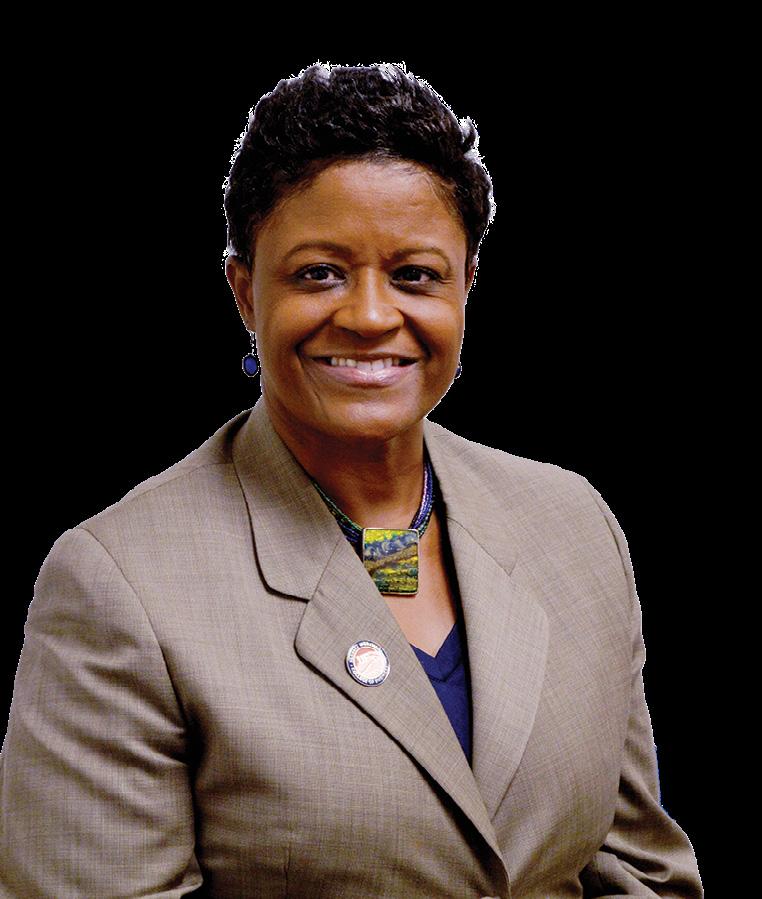
“I seek to influence current thinking on the experiences of civil engineering students with disabilities. In so doing, the practical outcomes I aim for are strategies that boost the students’ engineering identity, shift the culture of engineering to being more inclusive, facilitate/help, in this case, students with disabilities to complete an engineering degree, and promote their full participation in the engineering workforce,” Dr. Simmons said. “Frankly,
“The overarching aim of my research is to realize a diverse and inclusive workforce in civil engineering, and the work that led to this paper was a growth experience for me,” Dr. Simmons added. “As I contributed disciplinary and methodological knowledge, I received a better understanding of students with disabilities. For that, I thank the participants of the study and my co-authors.”
Kyle A. Riding, Ph.D., a civil engineering professor, has been named a Fellow of the American Concrete Institute (ACI). Dr. Riding is one of 20 members inducted into the 2022 class.
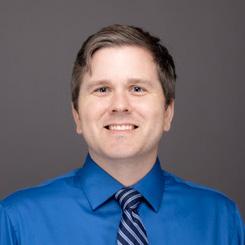
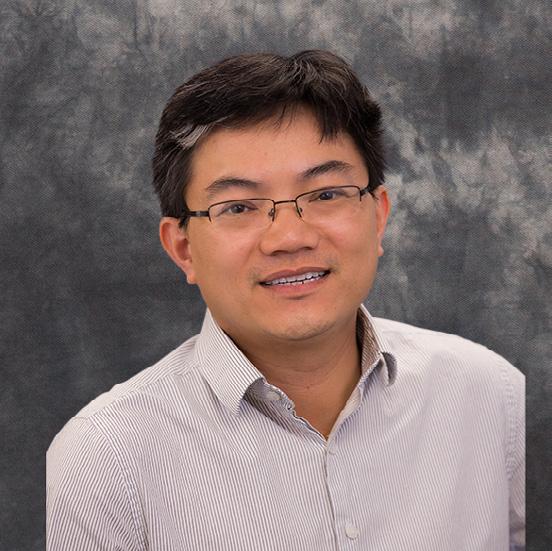
thought leaders,” he said. “I received a graduate fellowship from ACI when I was in graduate school. That kept me involved as a grad student and helped me see the importance of ACI in the profession.”
Dr. Riding has been a member of ACI for nearly two decades. Throughout his tenure, he served as chair of the ACI 231 Properties of Concrete at Early Ages committee. He is also a member of the 318A Structural Concrete Building Code: General, Concrete, and Construction subcommittee along with the ACI 201 Durability of Concrete, 207 Mass and Thermally Controlled Concrete, 236 Material Science of Concrete, and the Walter P. Moore Award committees.
KYLE A. RIDING, PH.D.“To me, it is a really high honor to be elected by my peers as an ACI Fellow. I am humbled, and it is something that I will cherish,” he said.
The institute inaugurated the Fellow designation in 1973. A Fellow is a high honor bestowed upon an active member who has been a member for at least 15 years. The member must have made outstanding contributions to the field of concrete materials.
Dr. Riding specializes in concrete durability research, which includes early-age concrete behavior, mass concrete construction and ultra-highperformance concrete methods.
“Dr. Riding has helped propel ESSIE to national prominence in the sustainable and responsible use of the world’s most common humanmade construction material,” said Kirk Hatfield, Ph.D., ESSIE director.
For Dr. Riding, this is a full-circle moment. He joined ACI when he was pursuing his doctoral degree. “I’ve been a member of ACI since 2003. I joined when I was a graduate student and attended my first ACI conference that fall. Involvement in ACI has greatly contributed to my career and helped me learn about new topics in concrete materials science and technology and helped me meet and get to know industry
Christopher Ferraro, Ph.D., P.E., a civil engineering assistant professor, has received the ACI Delmar L. Bloem Distinguished Service Award for his work on technical committees. Dr. Ferraro is one of three recipients to be awarded for 2022.
FERRARO, PH.D., P.E“Dr. Ferraro’s service award is well earned,” Dr. Hatfield said. “The volume and quality of his professional and academic service are extraordinary, particularly for a faculty member so early in his career.”
The Institute’s Board of Directors selected Dr. Ferraro for his outstanding leadership on the ACI Committee 207, in which he has been chair since 2016.
“This level of recognition is truly an honor, and I am humbled to receive this award,” Dr. Ferraro said. “The members of the committee generously donate their time to revise guidance documents. Our goal is to make massive concrete structures and elements more efficient, durable and sustainable.”
This recognition was established in 1969 as the Distinguished Service Award, and it was later renamed in 1972 to honor Delmar Bloem, a dedicated member who passed. The honor is bestowed to a chair who has done outstanding performance on their committee.
Dr. Ferraro joined ACI in 2002, became a professional member in 2011 and was named a Fellow in 2017. He said he joined ACI because it is a leading global authority for the development, dissemination and adoption of its consensus-based standards, along with its technical resources, educational and certification programs.
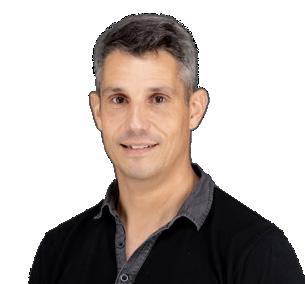
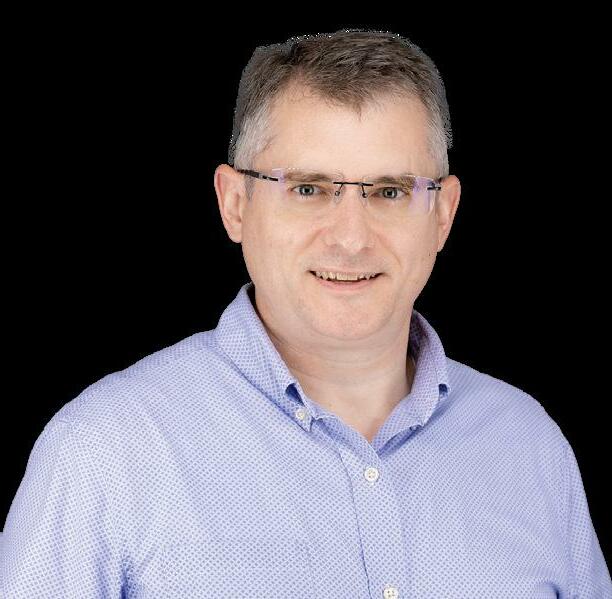

Dr. Ou’s research interests include sustainable construction engineering and community resilience. Her research is inspired by the communitycentered informed hazardoriented decision-making.

Dr. Smith is a coastal processes researcher with experience in numerical modeling, coastal and wave processing, storm surge sediment processing, hydrodynamics, field measurements and project development.
Dr. Yan’s research focuses on using data science and machine learning to make transportation more equitable and sustainable. He takes an interdisciplinary approach to transportation research that connects technological innovations with community needs.

 by Reba Liddy
by Reba Liddy
Sophie Spratley, Ph.D., an academic advisor in the Department of Civil & Coastal Engineering, was named the University of Florida’s (UF) Professional Advisor of the Year. She is the sole recipient of the
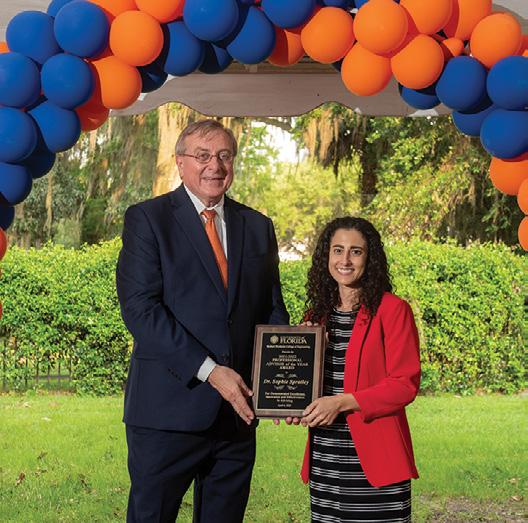
“Sophie is an amazingly talented and dedicated individual and we are incredibly fortunate to have her on our team. We are delighted that UF is giving her the recognition that we feel is well-deserved,” said Robert J. Thieke, Ph.D., head of the Department of Civil & Coastal Engineering and undergraduate coordinator.
Dr. Spratley has been an academic advisor in the Department of Civil & Coastal Engineering for six years. “This award is meaningful to me because it recognizes the important role that academic advising plays in the educational mission of the university.”
She credits her advising colleagues for their help throughout her career. She said that the advising community has been a welcoming place where colleagues across campus help each other learn and support each other’s efforts.
In January, Dr. Spratley received the Herbert Wertheim College of Engineering’s Undergraduate Professional Advisor of the Year Award.
“Advisors work hard to ensure that students are connected to the university and have the resources they need to pursue their goals and develop their identities,” she added.
 by Reb a Liddy
by Reb a Liddy



Dr. Wu joined the Department of Environmental Engineering Sciences as an assistant professor in 1998 and was promoted to an associate professor six years later. In 2009, he was elevated to his current position as a professor. In 2013, two years after ESSIE was formed, Dr. Wu was appointed department head in environmental engineering sciences and served for six years until December 2019.
“CY was a major component of ESSIE’s formation. He has always been optimistic and energetic about the future of ESSIE,” said Kirk Hatfield, Ph.D., ESSIE director. “He led the way and was fearless when it came to making monumental changes in his department. He has been a big driver of innovation and the students adored him. He will be greatly missed, and we are grateful for his time here.”
to reduce COVID-19 transmission in indoor spaces. His research played a critical role in reshaping the World Health Organization (WHO) and Centers for Disease Control and Prevention (CDC) guidelines to mitigate the public from the virus’ exposure. He was featured in the Washington Post, Verywell Health and Texas Monthly for his COVID-19 research.
“My research aims to characterize aerosols and control air pollution from emission sources to better protect human health and the environment,” Dr. Wu said.
Prior to joining UF, Dr. Wu earned his bachelor’s in mechanical engineering from National Taiwan University in 1989, and his master’s and Ph.D. in environmental engineering from the University of Cincinnati in 1993 and 1996, respectively.
the highest regard since it was voted by students who he taught and mentored.



When asked about what he’d miss the most about his time at the university, he remarked, “everything. From my passionate and talented students who want to better the world and great colleagues who strive for excellence in environmental education and research and support each other, to the historic Black Hall, Lake Alice and UF Bat Houses.”
He served as a faculty advisor to 23 doctoral candidates and 35 master’s students and mentored 88 undergraduate students to conduct research. Currently, he is advising six Ph.D. students and four undergraduates in his lab. Dr. Wu plans to virtually meet with his UF students and provide guidance until they graduate.


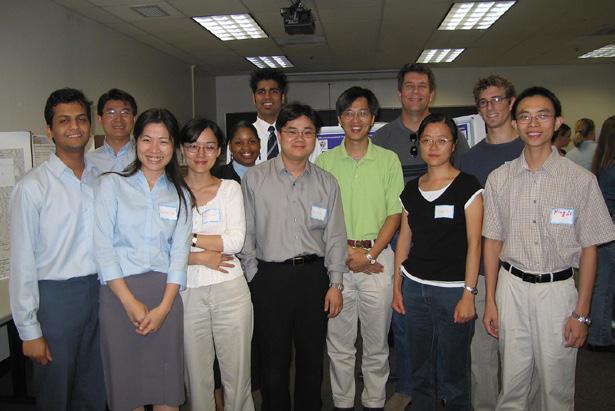
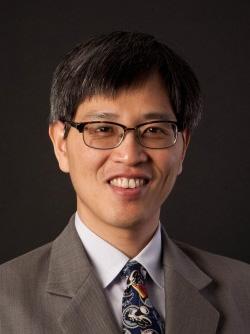
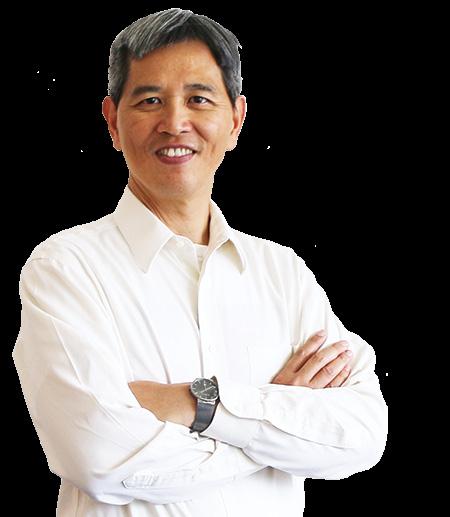
Throughout his tenure, Dr. Wu has been instrumental in aerosol research. In 2018, he used a first-of-its-kind air sampler that was roughly 20 times more efficient with capabilities for capturing viable influenza virus aerosol. More recently, he was on the frontlines with COVID-19 research. In 2020, he led a team of researchers to prove that SARS-CoV-2 in aerosols can be cultured, and it sparked the need to reevaluate safety protocols
Dr. Wu credited his nearly three-decade tenure to “top-quality students who are passionate about the environment, collegial colleagues who strived to build the best department, diverse research capabilities and portfolios on campus that facilitated innovative research.”
Among his dozens of awards and honors, he holds the 2000 and 2015 John J. McCreary Outstanding Faculty Award from the Society of Environmental Engineers in
“With collective wisdom, commitment and team spirit, we have been able to create an inclusive environment that allows students and faculty to better themselves. Together we have achieved a lot that no others have done before, and I am proud to be part of that, and for example, now we have a next-generation undergraduate core curriculum that integrates different aspects of environmental engineering sciences into a holistic one,” Dr. Wu added.
Dr. Prevatt shared how to prepare buildings for tornadoes and disasters following a series of deadly storms.
Dr. Prevatt wrote a perspective on better ways to protect people and property from catastrophic tornadoes.
Prevatt, Ph.D. Kisinger Campo & Associates Term Professor
“CREATING A MORE RESILIENT NATION: STAKEHOLDER PERSPECTIVES”
- SUBCOMMITTEE HEARING
Dr. Prevatt provided a written testimony to the House Subcommittee on Emergency Preparedness, Response, & Recovery on how we can become more resilient in wind-related disasters.
Dr. Behdad discussed how screens and batteries are important components when considering the repairability of electronics.
 Behdad, Ph.D. Associate Professor
Behdad, Ph.D. Associate Professor

THE WORLD NEEDS TO START PLANNING FOR THE FIRE AGETHE ATLANTIC Dr. Zhao provided commentary on wildfireevacuation research, and how it recently emerged as a major disaster.
Zhao, Ph.D. Assistant Professor
 Wu, Ph.D. Professor
Wu, Ph.D. Professor
THIS $14,000 AIR FILTER PROMISES TO “KILL” COVID. IS IT WORTH THE PRICE? - TEXAS MONTHLY Dr. Wu questioned the effectiveness of a company’s technology to combat COVID-19.
COVID-19 MAY HAVE SEASONS FOR
TEMPERATURE ZONES, STUDY SUGGESTSWASHINGTON POST Dr. Jutla and Dr. Wu discussed how climate conditions and human behaviors impact COVID-19 transmissions.
Dr. Jutla discussed the possibility of a cholera outbreak in Ukraine, and the use of prediction technology that can forecast potential outbreaks.
Associate Professor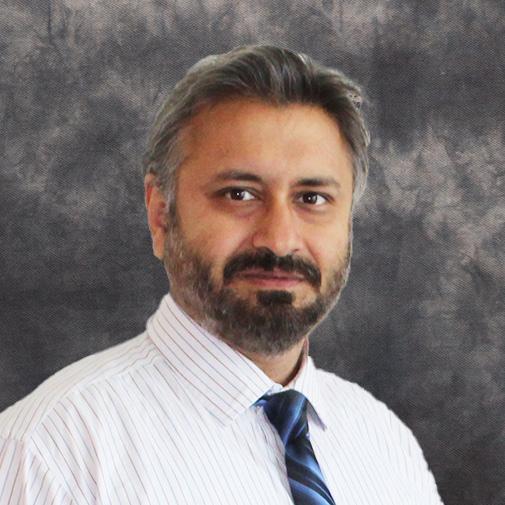
DIFFERENTXilei Chang-Yu Antarpreet S. Jutla, Ph.D.
This research roundup summarizes the top three partnerships announced in 2022.
In a new study that is the first to explain what some have long suspected, researchers found that human activity helps sustain and intensify naturally occurring red tide blooms in Southwest Florida.
Conducted by researchers at the University of Florida, Sanibel-Captiva Conservation Foundation and Sarasota Bay Estuary Program, the study found that while a combination of factors contributes to red tide blooms, human activity has played a consistent role in intensifying them during the past decade.
The researchers linked blooms in Charlotte Harbor and surrounding coastal areas to nitrogen inputs from the Caloosahatchee River, Lake Okeechobee and areas upstream of the lake. The study was published in the journal Science of the Total Environment.
“While red tide blooms develop naturally, we took a long view and found evidence that human activity has helped fuel coastal blooms in this estuary to varying extents between 2012 and 2021,” said Miles Medina, lead author of the study and a research scientist at UF’s Center for Coastal Solutions (CCS).
Determining what contributes to red tide intensification has been a priority for coastal states, as the harmful toxins these blooms create affect humans and sea and land creatures alike.
They found that nitrogen inputs from both coastal and inland parts of the watershed consistently intensified the blooms in the harbor.
To learn more, visit go.ufl.edu/red-tide-study.
Led by Christine Angelini, Ph.D., CCS director, the center has focused on strategic partnerships to innovate smart sensor networks, artificial intelligence technologies, model and mitigate coastal hazards.
 CHRISTINE ANGELINI, PH.D., CENTER FOR COASTAL SOLUTIONS DIRECTOR
CHRISTINE ANGELINI, PH.D., CENTER FOR COASTAL SOLUTIONS DIRECTOR
With $3 million in government funding through the U.S. Army Corps of Engineers (USACE), a team of UF researchers is now giving the Corps a sustainable framework for projects in this oftbattered ecosystem in Florida’s First Coast, where wind, storm waves and tides relentlessly threaten to undermine mitigation efforts. Led by Christine Angelini, Ph.D., CCS director, along with colleagues in ESSIE and Department of Geological Sciences, the multidisciplinary team hopes to provide these ecosystems the protection necessary to withstand and even thrive under unpredictable climatic conditions and the burden of their many uses — commercial, residential, recreational and tourism. Dr. Angelini explained that, to meet its core task of maintaining our nation’s vital waterway infrastructure, such as navigation channels, ports and flood protection structures, the USACE and other engineering entities have found it far easier to permit and secure funding for familiar hard engineering solutions, even though they often run contrary from a physical or biological standpoint. “Our goal is to work for them to provide some scientific flexibility and creativity where they don’t have the latitude to do that — restorative engineering on a scale that has tremendous implications for the future of these remediation projects in our economically and ecologically valuable coastal ecosystems,” she said.
To read the full article, visit go.ufl.edu/new-big-dig
by CCS and SAS Staff
CCS and the SAS Institute, a global leader in data analytics software, are joining forces to study the factors that influence water quality and the connections between water quality and economic activity in southwest Florida. Funded by the Florida Department of Environmental Protection and focused on the Charlotte Harbor estuary and its watersheds, the project aligns with CCS’ mission to innovate cutting-edge data analytics, modeling and artificial intelligence and provide leaders the insights they need to identify the decisions and investments that will make Charlotte Harbor an environmental restoration success story.
Tapping into SAS’ comprehensive expertise in data management and analytics, CCS and SAS will develop a web-based platform to allow researchers to explore, analyze and even visualize the data collected from the water in Charlotte Harbor and gain insights into effective clean water management techniques.
An interdisciplinary team of CCS researchers – hydrologists, oceanographers, ecologists, economists and computer scientists – will use these data to investigate the interdependencies among pollution, ocean circulation, coastal water quality and economics, and use satellite data to develop high-resolution water quality forecasting technology.
To read more, visit go.ufl.edu/ccs-sas-partnership
THIS RESEARCH BUILDS ON DR. JUTLA’S NEARLY 11YEAR JOURNEY OF PREDICTING INFECTIOUS DISEASES. HE WAS INSPIRED BY DR. COLWELL’S LECTURE, IN WHICH SHE DISCUSSED SATELLITES TRACKING VIBRIOS. THAT LECTURE LED DR. JUTLA TO STUDY HYDROEPIDEMIOLOGY WHERE HE STARTED WORKING ON WATER AND ITS RELATION TO INFECTIOUS DISEASES.
Cholera impacts 1 million to 4 million people worldwide on an annual basis, according to the Centers for Disease Control and Prevention (CDC).
If this bacterial disease is not treated in a timely manner, it can be fatal.
Antarpreet Jutla, Ph.D. , an environmental engineering sciences associate professor in the Engineering School of Sustainable Infrastructure & Environment (ESSIE), along with researchers and humanitarian advisors from other institutions, created a one-of-its-kind portal to predict and prevent cholera outbreaks. With a $1 million grant from NASA, the University of Florida (UF) will become one of the first institutions primed to understand the patterns of this disease’s emergence in several parts of the world with the use of prediction tools.
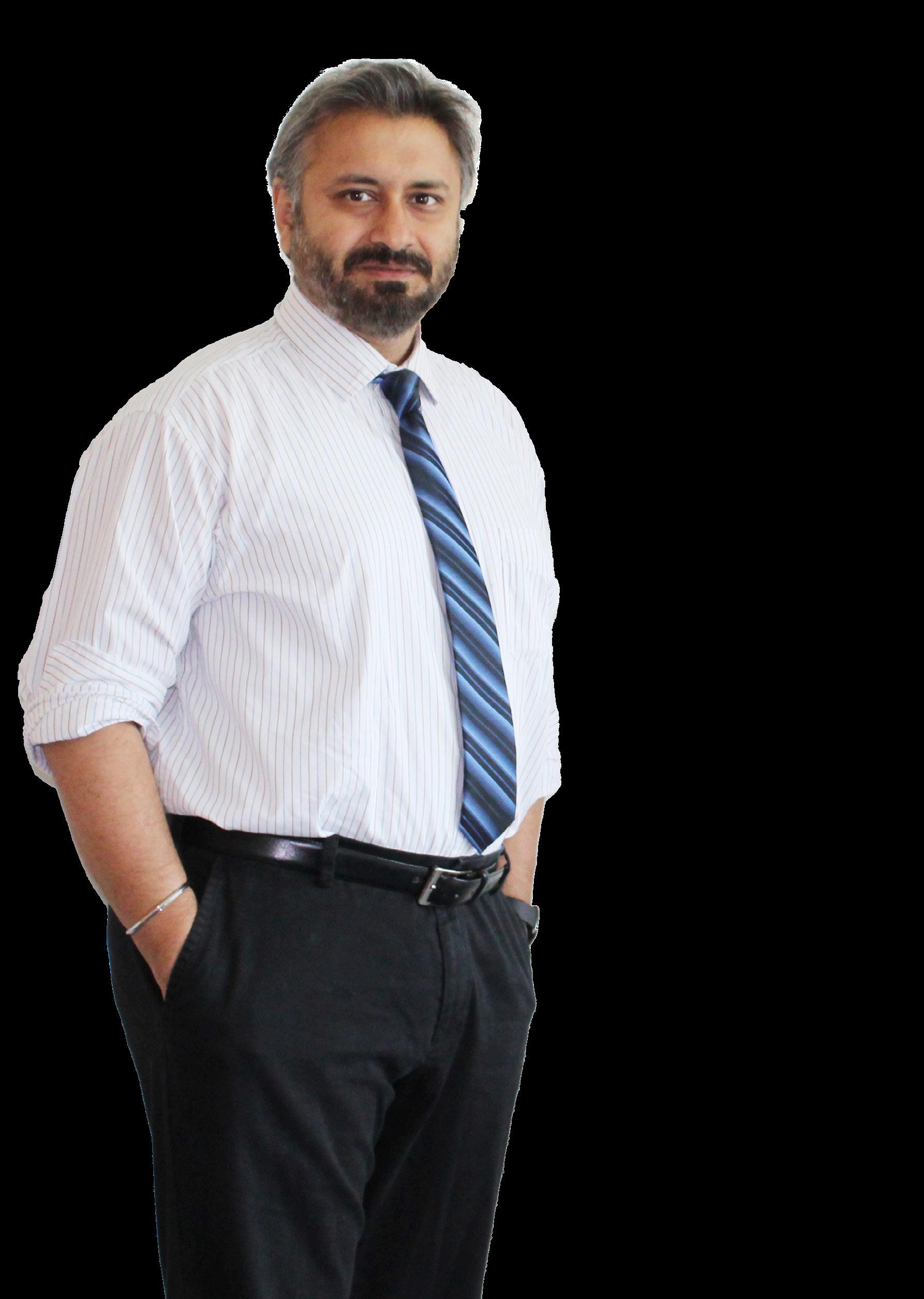
The research grant will focus on developing protocols for strengthening anticipatory decisionmaking for infectious diseases of the future. The team will also harness the power of digital technologies and develop one of the first apps for water-borne infectious disease.

Similar to a forecast model, the Vibrio Prediction Hub houses the Cholera Risk Map, which is an interactive, web mapping platform that predicts whether there will be a cholera outbreak based on weather conditions and water quality. The hub uses an interface similar to the COVID-19 Risk Map that Dr. Jutla created with Rita R. Colwell, Ph.D., an environmental biologist and Distinguished University Professor at the University of Maryland, and Chang-Yu Wu, Ph.D., an environmental engineering sciences professor in ESSIE. The map uses machine learning and satellite data to predict future COVID outbreaks.

“We first chose cholera because that was the only pandemic happening in the world for centuries. This disease is unique since we know the solution to limit the outbreak—provide clean water and sanitation facilities—but there are regions in Africa, Asia and some parts of Latin America that don’t have such infrastructure yet,” Dr. Jutla said.
The Cholera Risk Map is updated weekly, and data are pulled from regional satellites. The funding from NASA will allow researchers to expand the data to reach beyond currently selected regions. This funding is part of NASA’s Health & Air Quality program, which was created to address “toxic and pathogenic exposure and health-related hazards and their effects for risk characterization and mitigation.” The goal is to make a realtime assessment and prevent the spread in populations susceptible to outbreaks.
“Satellite data sets continue to play a critical role in the development, calibration and validation of the algorithms. We continue to get high spatial and temporal resolution of data that can now capture precise location where risk of cholera is likely be high,” Dr. Jutla added. “We will be channeling our resources to the locations where the risk is going to be high, and then telling our end users to collect clinical surveillance data or water samples for microbiological analysis.”
In building a worldwide cholera surveillance and prediction system, Dr. Jutla continues to
work with Dr. Colwell, Ali Akanda, Ph.D., an associate professor and graduate director at the University of Rhode Island, the U.N. Office for the Coordination of Humanitarian Affairs (OCHA), and the United Kingdom’s Foreign, Commonwealth & Development Office (FCDO).
“The capability of predicting risk of infectious diseases outbreaks weeks in advance provides an incredibly important tool for public health,” Dr. Colwell said. “It offers the opportunity to prepare and thereby save lives and prevent human suffering. It has been a challenge to perfect the model for cholera, and we are delighted to have succeeded.”
Dr. Jutla predicts that it will take four to five years for the hub to be a fully functioning global resource.
Once successful, the research team plans to develop a holistic infectious water and airborne disease prediction center to preemptively determine an impending outbreak.
“Right now, all the indicators suggest that we are going to be close to achieving the idea that we will have a working disease prediction algorithm for parts of the world that need it the most,” Dr. Jutla said.
After individuals are diagnosed with COVID-19, they are required to quarantine at home. If they live with others, they are encouraged to isolate themselves in a separate room to reduce exposure of the other individuals to the airborne virus.
Researchers at the University of Florida found that residential settings might be hotspots to spread SARS-CoV-2, the virus that causes COVID-19, due to poor ventilation in homes and the relaxed usage of masks. As part of this study, researchers were also the first to demonstrate a viable, or infectious, virus on the surface of a cellphone.
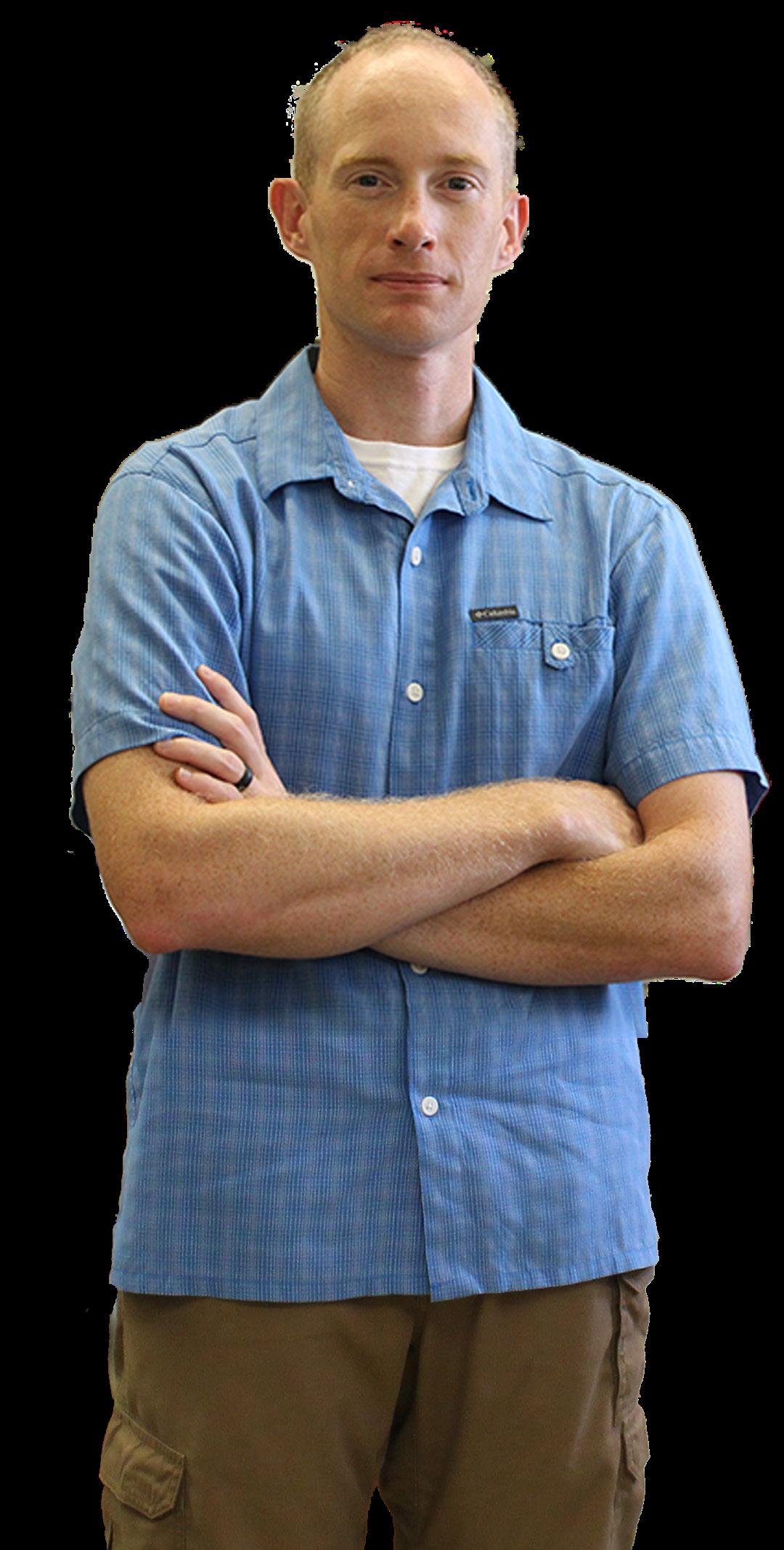
This study, initiated by William (Brad) Vass , a firstyear doctoral student in the Department of Environmental Engineering Sciences within the Engineering School of Sustainable Infrastructure & Environment (ESSIE), assessed air and surface samples for the presence of SARS-CoV-2 from a self-isolating student with COVID-19.
“People spend a lot of time in their homes, and when a person in a home gets sick, others have difficulty avoiding the sick person. Understanding where viable viruses
WILLIAM (BRAD) VASS CHANG-YU WU, PH.D.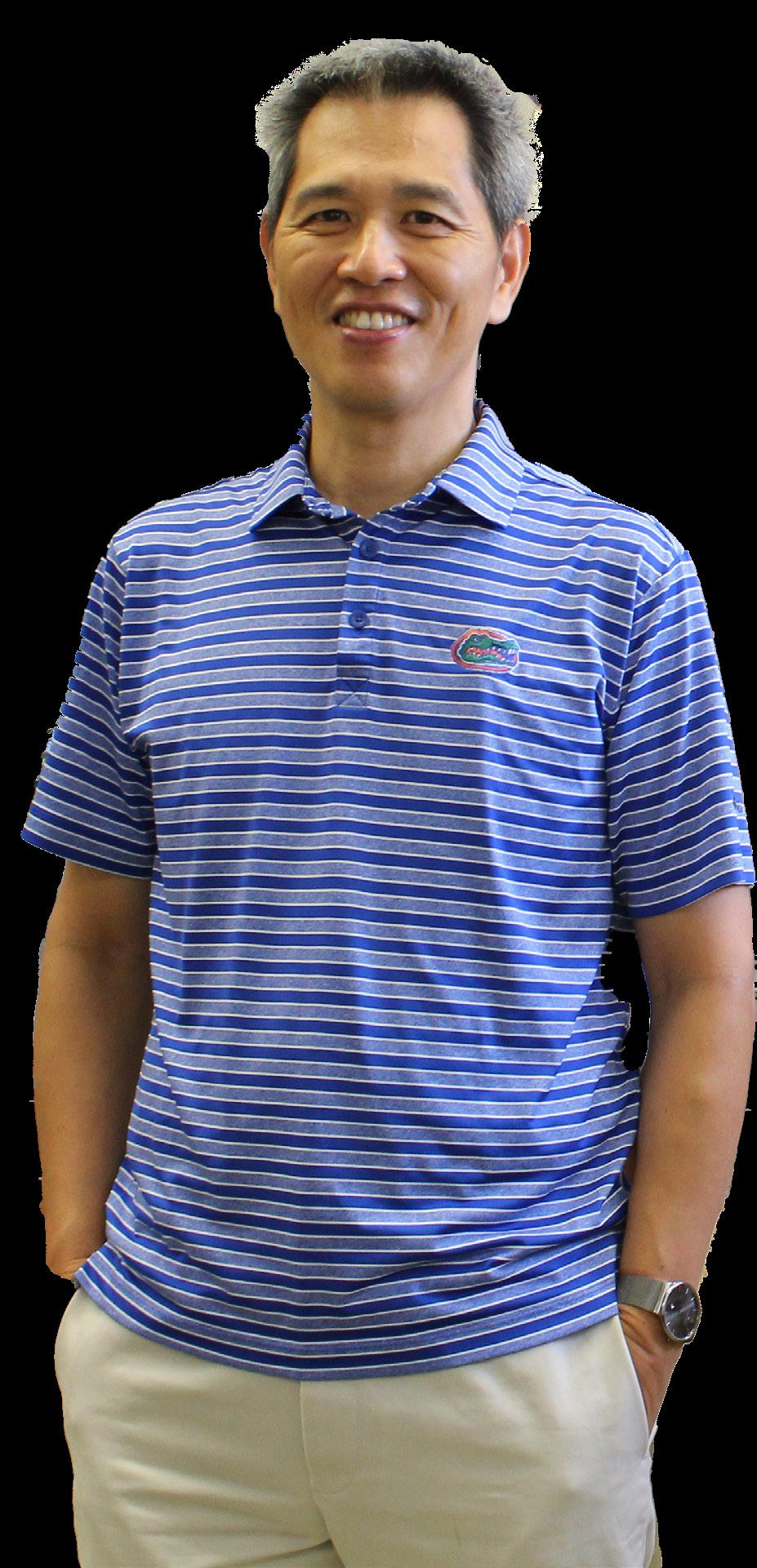
can be detected in residential environments can help us better inform the community about preventing virus exposure in homes,” Vass said.
Vass wanted to conduct research in a residential environment with a self-isolating individual with the illness to understand whether the virus is present in the air and the extent to which it spreads. He worked with Chang-Yu Wu, Ph.D. , a professor in ESSIE and mentor; John Lednicky, Ph.D., a professor in the Department of Environmental and Global Health at the College of Public Health and Health Professions and a member of the Emerging Pathogens Institute; and Hugh Fan, Ph.D., an Excellence Term Professor in the Department of Mechanical & Aerospace Engineering.
This project was funded by a $1.4 million grant from the National Institutes of Health’s (NIH) National Institute of Allergy and Infectious Diseases (NIAID) led by Dr. Fan and a sub-award from Aerosol Dynamics Inc. to UF through NIH’s Small Business Innovation Research Program (NIH SBIR).
Dr. Wu’s research team, led by Vass, used a device to carefully collect air samples around the student’s home. The team found that virus particles collected during sampling remained capable of causing infection. The device uses water molecules to coat and enlarge the particles for virologists to assess in the laboratory in a process similar to research conducted in 2020.
Vass also collected surface samples from items inside the student’s bedroom — their cellphone, laptop, chair arm — along with surfaces outside of the bedroom — a table and a desk across the residence — to test whether the virus was transported to parts of the home beyond the isolation room.
“Environmental surveillance is a powerful tool that allows us to understand whether the virus is spreading at a select location, and often, how it does, so that we can set better mitigation measures to lower the exposure risk to the public,” Dr. Wu said.
Vass transferred the samples to Dr. Lednicky for further study. Dr. Lednicky detected the virus by real-time reverse transcription polymerase chain reaction (RT-PCR), quantified the amount of virus present in the samples, isolated the virus in cell cultures, and interpreted the significance of the genetic
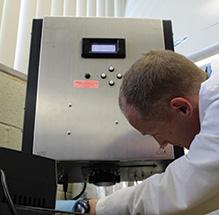
sequences.
The team’s findings indicated that airborne SARS-CoV-2 delta variant was present near and beyond 6 feet of the infected student. The virus spread beyond the room throughout the home.
“Most aerosol research related to COVID has focused on what happens in hospitals and public spaces. But the real concern now should be trying to understand what happens in the homes of people with COVID patients,” Dr. Lednicky said. “Our work was one of the first to examine the potential risks of breathing air in a home housing a COVID patient. Moreover, the virus was a delta variant, which is more easily transmitted person to person. Before, there was little information about the virus in air samples. Our work shows that it is present in the air.”
The virus was also detected on the student’s cellphone. Until now, no one has detected the virus live from a surface; before, the viable virus was only detected from air particles.
“This is the first-ever real-world report of the viable SARSCoV-2 collected from the surface of a cellphone,” Dr. Wu said. “If an individual touches the contaminated surface and then inadvertently touches their eyes, nose or mouth, the viable virus gets a chance to enter the human body, which is called ‘fomite’ transmission. So, people must be careful not to touch each other’s cellphones, as the exhaled breath (like from talking or coughing) onto the phone by an infected individual can pass the virus to them through this way.”

The research team hopes to sample more residential areas for data points, which will help identify ways to reduce the spread of coronavirus. This research also has the potential to expand beyond SARS-CoV-2 detection to learning how other respiratory viruses, such as influenza viruses, would spread similarly.
“We hope that the public will use this study, and others in a growing body of research related to respiratory viruses in aerosols, to help themselves make decisions about how best to protect themselves and others when someone in their home becomes sick from a respiratory virus,” Vass said.
To read the full study, visit https://doi.org/10.1016/j. jaerosci.2022.106038
The University of Florida’s Eckhoff Steel Bridge team has done it again.
The team placed first in the American Institute of Steel Construction’s (AISC) Student Steel Bridge National Competition for the second year in a row. The competition was hosted by Virginia Tech on May 27 and 28 with more than 140 participating schools internationally.

“The team, including myself, didn’t fully know what to expect as this was my first in-person Nationals. We knew we had a competitive bridge but there are many variables and some luck involved in finishing in the top three,” said Taylor Rawlinson, Ph.D., a research assistant scientist in the Department of Civil &
Coastal Engineering and the faculty advisor for the group. “The team put in a lot of time between regionals and nationals to improve their structural stiffness and construction time, and I’m proud of their commitment and effort.”
This was the first time since 2019 that schools were able to compete inperson in the national competition. In 2020, the competition was canceled due to COVID-19, and last year’s competition was held virtually across the participating institutions’ campuses. This year’s challenge was for students to design, fabricate and construct a one-tenth scale steel bridge that mimics a real-life design and construction project.
Fletcher D’Arcy, a graduating civil engineering senior and the team’s project manager, said that the new, inexperienced yet enthusiastic members contributed to the group’s success through countless hours of trial and error and collaboration. The spring graduate added, “It’s reflected to me what my priorities as a designer are and what they should be—and the modes of thinking required to be successful in a high-stress environment, which is like an engineering firm.”
D’Arcy worked with Joseph Brock Sullivan, a civil engineering senior and the build team manager, to assemble over 25 pieces with more than 50 bolts in under five minutes. The group
placed first in economy, which was construction speed multiplied by the number of builders. The team placed third in construction speed and fourth in efficiency, which includes stiffness and weight. The team also won the Frank J. Hatfield Ingenuity Award for the unique

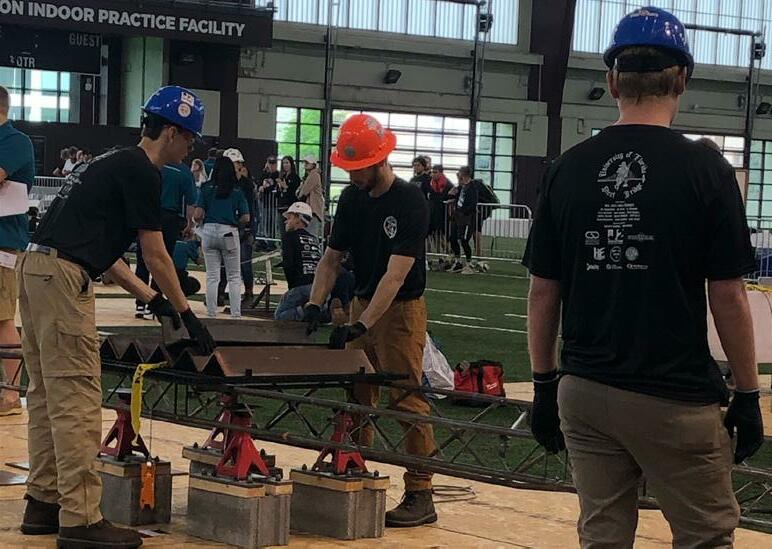

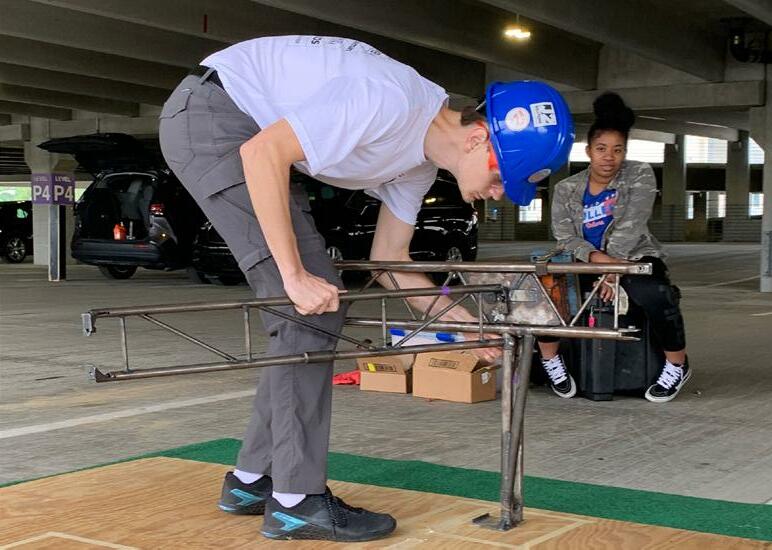
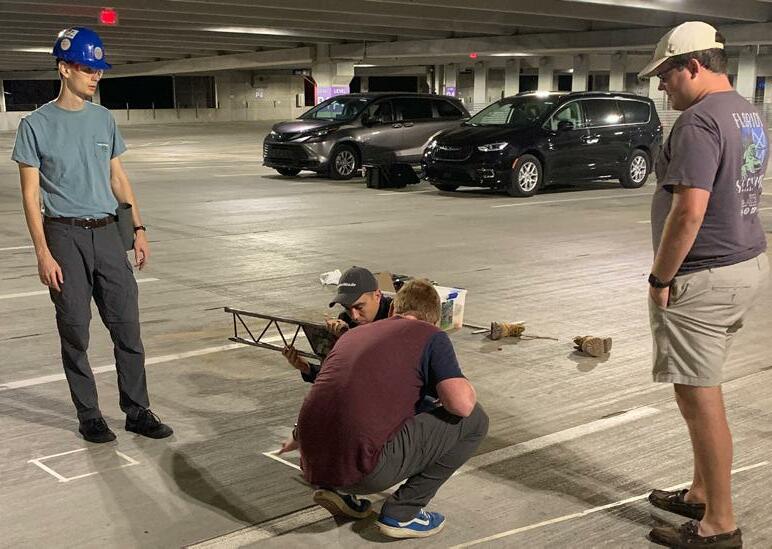
bridge construction as the only school to use two builders in the construction of the bridge with most other schools utilizing at least three or up to six builders.

“Being on a design team such as Steel Bridge has provided me with an incredible opportunity to utilize the skills I have learned in my courses, constantly learn more about the techniques and principles used in my industry, gain considerable leadership experience, bolster my resume, and meet a bunch of great people who enjoy the same things as me,” Sullivan said.
This is the team’s fourth national championship since its inception. The first win occurred in 1997, the following two wins were 2015 and 2021.

This year’s win has the newest members excited for next year’s competition. Donald Stowell-Moore, a civil engineering junior, said that he’d recommend anyone interested in joining the group to reach out.

“This win has meant so much. I




remember walking on stage with the rest of the team and feeling exuberated,” he said. “This was my first year on the team, and next year I will be leading the fabrication portion of the bridge. I really feel pride in the fact that I can contribute to a team with the knowledge that I am a Gator and always will be.”
Other national team members include Taylor Sadhi, a civil engineering senior, Anthony Ortegon Perez, a civil engineering junior, and Josh Lucero, a civil engineering sophomore. Many of this group will be returning to next year’s competition. As they celebrate this year’s win, they anticipate competing next year.

“We look forward to future competitions as we continue to innovate as a team and develop strong Gator Engineers who can blend the theoretical and practical aspects of civil engineering. We have a strong core coming back next year, and I’m excited about the future of the Eckhoff Steel Bridge program,” Dr. Rawlinson added.
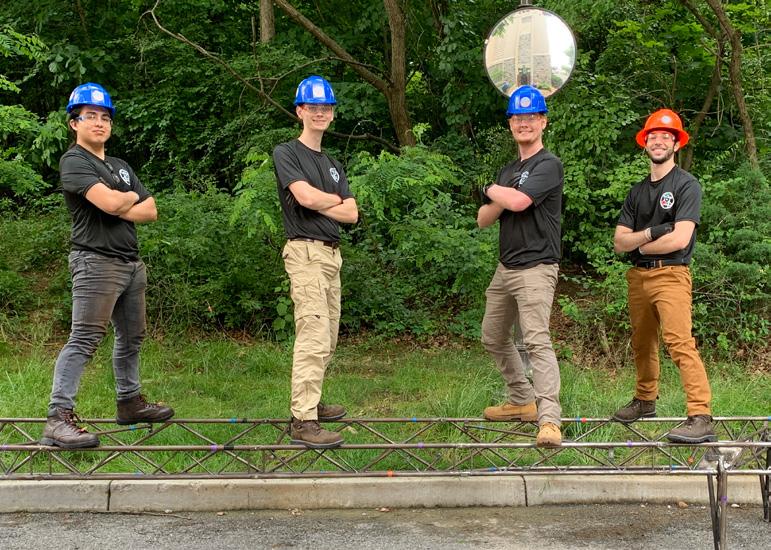
Qi “Judy” Zhu, Ph.D., was a recipient of the Herbert Wertheim College of Engineering’s Creativity award. Prior to graduating with a doctorate in civil engineering, Dr. Zhu was a doctoral candidate in the Informatics, Cobots and Intelligent Construction (ICIC) Lab, led by ESSIE Associate Professor Eric Jing Du, Ph.D.
“We are so proud of Dr. Zhu and wish her an exciting academic career! As an international student and a female engineer, Dr. Zhu sets an exceptional example for my lab - 22 papers published in four years, three university awards including Gator Engineer Award and 3 patent apps,” Dr. Du said.
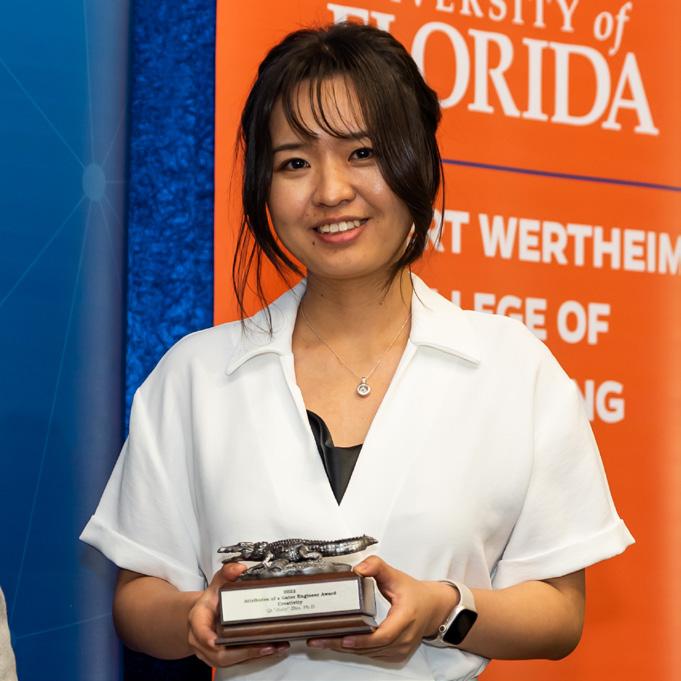
Dr. Zhu now serves as a a post-doctoral research associate in the ICIC Lab.
“Sripriya chose this path for her career because she wanted to better the world through engineering. Her vision, initiative, leadership and the impact of her actions really best exemplify ‘Service to the Global Community’ in the COVID era,” said academic advisor Chang-Yu Wu, Ph.D.
Nannu Shankar is a doctoral candidate in Dr. Wu’s aerosol research group. Early in the pandemic, she initiated air sampling at healthcare facilities. Her findings proved the aerosol transmission pathway of the virus, and the knowledge was adopted by disease prevention agencies in devising better strategies to protect public health worldwide.
Danielle Weisenfeld, a fifth-year undergraduate civil engineering student, was named a University Scholar from the University of Florida. She is one of 40 engineering students named a Scholar.

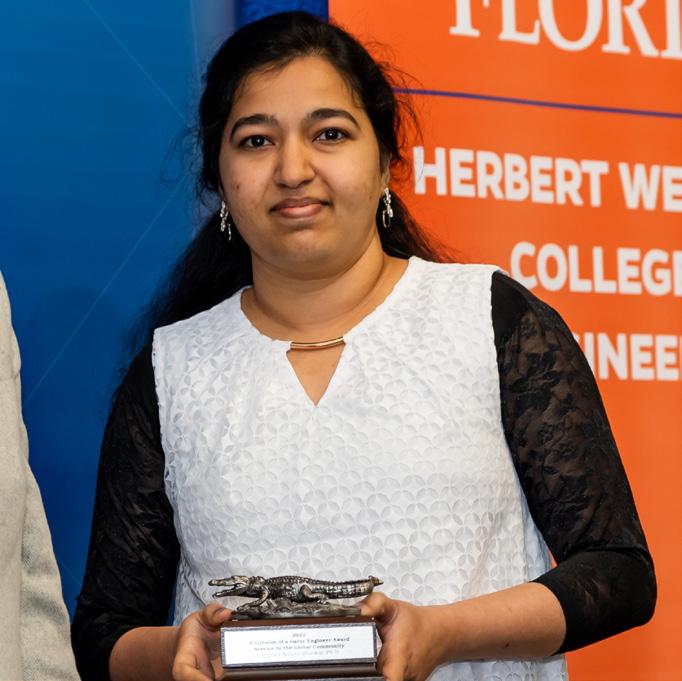
“While a member of my research lab, Danielle has made significant and consistent contributions across a host of critical, team and research-supporting related activities that have culminated in the publication of research. Her curiosity allows her to expertly complete research tasks assigned to her. Her writing ability is superb and has resulted in published research,” said academic advisor Denise R. Simmons, Ph.D.
She has worked in the Simmons Research Lab research group for two years under Elizabeth Volpe, EIT, a doctoral student and mentor. Weisenfeld is majoring in civil engineering and minoring in sustainability and the built environment. She is active in Engineers without Borders and the National Society of Black Engineers.
• Received third place in poster presentation at the University of Florida/University of Illinois at UrbanaChampaign Aerosol Symposium
Amanda R. Chappel
Received the 2022 AWRA Florida Sandy Young Scholarship
Received third place in poster presentation at the University of Florida/University of Illinois at UrbanaChampaign Aerosol Symposium
• Received the Federal Highway Administration Award’s Dwight David Eisenhower Transportation Fellowship Program Research Fellowship Grant
• Placed first in the Florida-Puerto Rico District ITE Collegiate Traffic Bowl
Received the Environmental Protection Agency’s Oak Ridge Institute for Science and Education Fellowship
Received an honorable mention in the National Science Foundation’s Graduate Research Fellowship Program
Sripriya Nannu Shankar
• Air & Waste Management Association’s Axel Hendrickson Scholarship
University of Florida Clinical and Translational Science Institute TL1 Fellowship
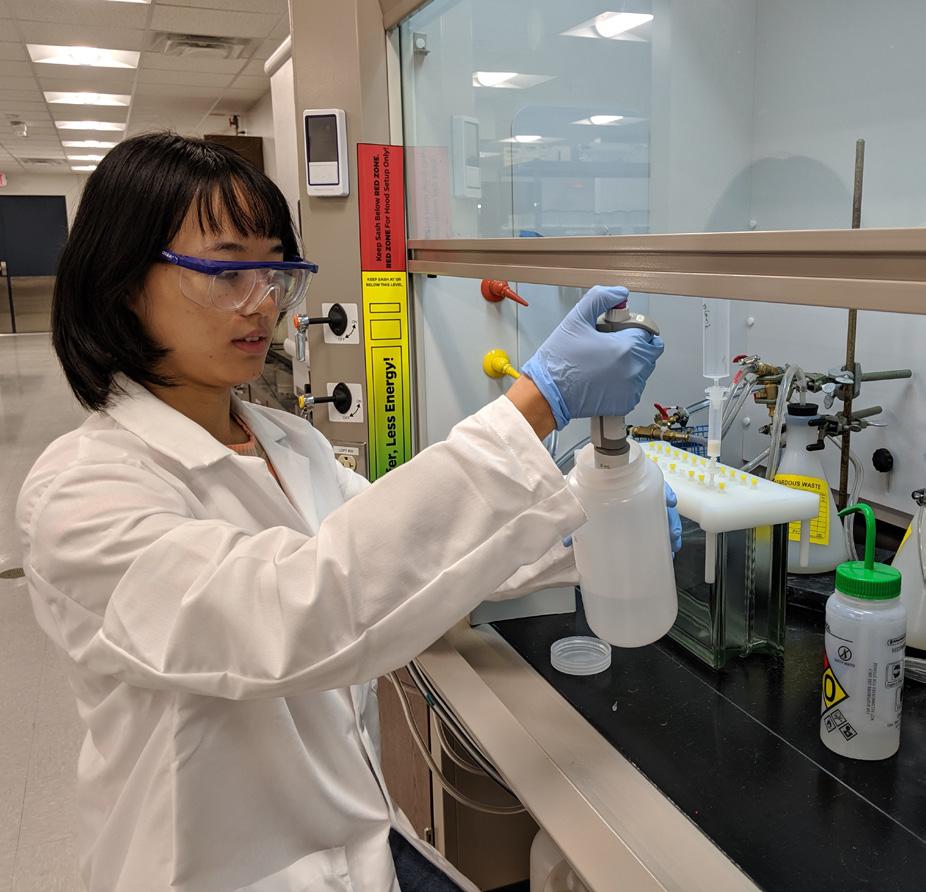
“Brad”
• Awarded a scholarship from the Uniformed Services Environmental Health Association for attendance at the 2022 National Environmental Health Association Annual Educational Conference
• Selected for a tuition-paid Ph.D. program funded by the U.S. Army Medical Department
University of Florida’s International Student Certificate of Outstanding Achievement
DIVERSIFY
The University of Florida’s Association of Hispanic Alumni (AHA) recently selected Carlos A. Penin, PE, (CCE, ‘77) to receive the 2022 Gran Caimán of the Year award for his passion, commitment and leadership beyond engineering.
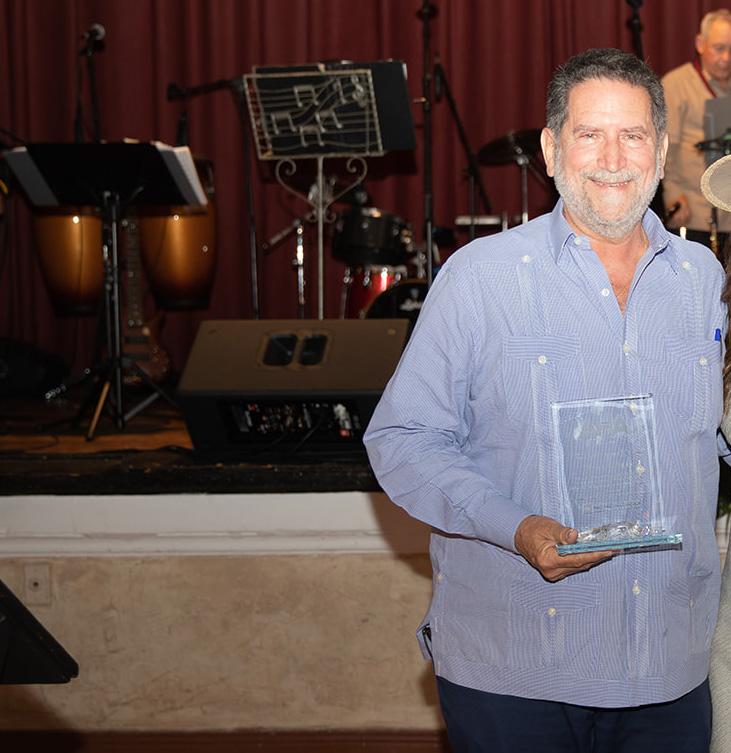
“I am humbled beyond words in receiving this honor. First, it recognizes my Cuban American heritage, and second, I join many great Hispanic Gator Alumni that have preceded me in receiving such an honor,” Penin said. “Finally, I can leave a legacy to my three daughters and my future grandchildren that the UF-AHA found me worthy of such an award.”
Born in Cuba, Penin, his three sisters and mom, sought refuge in Miami early in his childhood. Since then, Penin has considered South Florida his home. His passion for engineering sparked in high school and early college when he saw that engineers can improve people’s lives across the world and in everything that they do.
“I took in all of college life. I stayed active in a couple engineering societies, joined
a fraternity, and still found time to study very long hours,” Penin said. “I think that the friendships that began during these years can continue for a lifetime. I remember attending a homecoming game where an engineering colleague offered me a job that I eventually accepted. This resulted in a major milestone in my future engineering career.”
Penin received his bachelor’s degree in Civil Engineering and Construction Management from UF in 1977 and earned his master’s degree in Environmental and Urban Systems from Florida International University in 1982.
Penin’s early career focused on civil engineering and site design for various South Florida developers. He was later involved with larger projects that included building the Joe Robbie Stadium (now known as the Hard Rock Stadium), widening of the Julia Tuttle Causeway, and reconstruction of Southwest 8th Street, known as Calle Ocho in Little Havana. At one point,
Penin was managing multiple projects and clients for an engineering firm, while also being active in his community. A poor evaluation from a superior suggesting he was doing too much ended up being a significant motivation.
“Eight years after I started my company and after receiving a national award from the Inc. 500, I thanked him for the evaluation,” Penin said.
In 1989, he formed C.A.P. Engineering Consultants Inc., now known as CAP Government Inc., which has been widely recognized as a top firm for building department services exclusively for the government by Inc. 500, Gator100, Zweig Group and other organizations. Throughout his engineering firm’s tenure, Penin learned that through his faith and hard work, success will follow.
“As a company owner, my most difficult times were in finding the appropriate management and staffing to meet the client’s needs,” Penin said. “Owning your own company requires hard work, savvy, street smarts, relationships and
leadership. Early on, you must be a good engineer, but later you have to hire good engineers. My challenge was having the patience and maturity to accept failures but to continue to work hard knowing that you will eventually persevere.”
Along with running his company, Penin has been able to be active in the community. He serves as a mentor at the Belen Jesuit Preparatory School in Miami and donates his company’s services to the school’s development projects. Last year, his company hired over a dozen UF engineering students to help build their resumes and obtain experience in efficiency and management. Penin also serves as a member of ESSIE’s Advisory Board, which allows him to bring an industry perspective to academia and keeps him involved in the future of engineering.
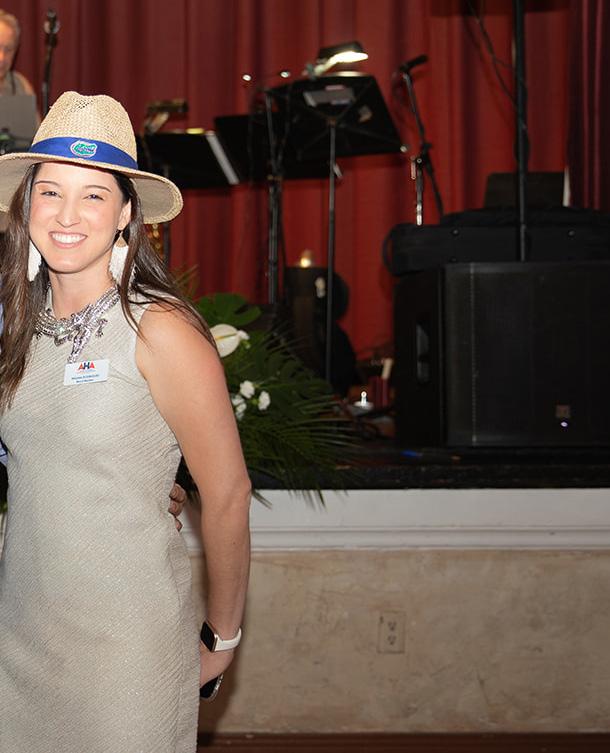

He advises students to study hard, stay involved in professional and community organizations, and accept that while failure is inevitable, they will not be measured by how many times they fall but by how many times they persevere.
“I would like to be remembered for being an engineer that cared for my profession, pursued the American Dream by establishing my own engineering company in the greatest country in the world,” Penin said. “I would like to think that over the last 33 years that I have owned my company, we have provided our employees professional and challenging jobs, we have served our clients accurately and responsively, and we have given back to our community unselfishly.”
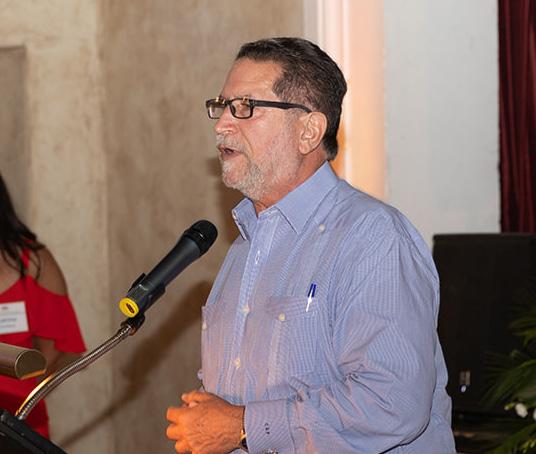
EARLY ON, YOU MUST BE A GOOD ENGINEER, BUT LATER YOU HAVE TO HIRE GOOD ENGINEERS.Carlos A. Penin, PE, (left) and Regina Rodriguez, Ph.D., (right) attending the University of Florida’s Association of Hispanic Alumni Gator Guayabera Guateque event. Carlos A. Penin, PE, gives an acceptance speech for UF AHA’s the 2022 Gran Caimán of the Year award.
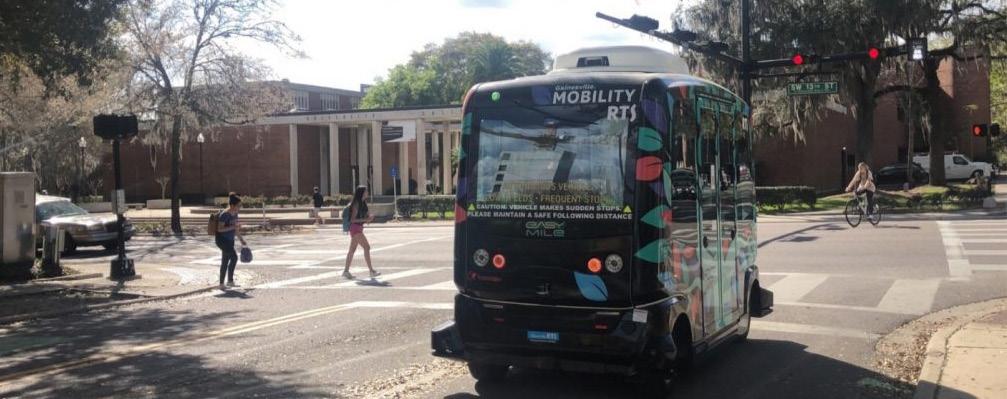 by Ines Aviles-Spadoni and Mitch D’Arrigo
by Ines Aviles-Spadoni and Mitch D’Arrigo
On any given day, Gainesville’s Autonomous Shuttle (AV) can be seen driving around city streets, interacting with pedestrians, bicyclists, and conventional vehicles, while picking up and dropping off riders along its route. AV shuttle corridors across the country are mostly designed without traffic lights, or the shuttles are maneuvered through traffic lights manually by an attendant. However, the Gainesville AV is different.
The shuttle can now communicate with traffic signals and make right or left turns without the assistance of a human operator. This advancement in autonomous shuttle technology is the result of research funded by the Florida Department of Transportation and the University of Florida (UF) Office of Research, in collaboration with Yunex Siemens, who supplied the roadside units (RSUs) and Transdev, the EasyMile shuttle operator.
In addition to the RSU and OBU connectivity projects, and as part of Phase 2 operations, Gainesville’s Regional Transit System (RTS) and
Transdev have extended the route near UF’s campus.
The shuttle can communicate with traffic lights thanks to the implementation of an onboard unit (OBU), a communication device that receives transmissions from RSUs. The RSU is mounted on the mast arm pole, which is the vertical component that holds the traffic lights.
“In Gainesville, because the RSU can talk to the OBU, the shuttle can make decisions on whether to stop, go or make a right or left turn on its own,” said Pruthvi Manjunatha, Ph.D., research assistant professor, and manager of the I-STREET Living Lab. “The shuttle knows whether it’s red or green because it is getting the signal from the RSU and can make decisions, operating autonomously.”
The I-STREET Living Lab includes
a network of roads containing advanced infrastructure on which the shuttle operates, and where other technologies such as connected and autonomous vehicles, smart devices, and sensors are tested. The Living Lab is also where new applications related to safety and mobility are created.
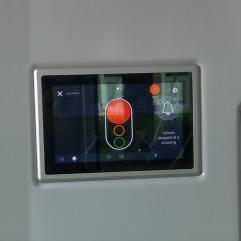
Other studies led by Dr. Manjunatha focus on the public’s readiness and comfort level and willingness to interact with AVs. The studies have shown generally positive responses from the public, with a need to improve the speed of the shuttle.
“By identifying the barriers and facilitators of AV use, we will expedite the deployment of the technology from both a policy and practice perspective,”
Dr. Manjunatha said. “We expect this will reduce transportation operating costs, attenuate the environmental impacts of transportation, improve the community’s social justice quotient, and save pedestrian, bicyclist, and vehicular lives.”
The earliest known use of concrete is a floor that dates back to Galilee, circa 7000 BCE, still sound when unearthed in 2007. After thousands of years as the go-to building material, it might seem like science surely could come up with something better, perhaps a material that doesn’t crack or crumble when used in columns or sidewalks.
And science can, says UF civil engineering researcher Christopher Ferraro
The problem is that many materials that are stronger or more durable than concrete don’t provide clues that something is wrong. The cracks in concrete are a signal, Ferraro says, one that can save lives.
“Concrete will show signs of distress. It’ll start cracking and start spalling,” says Ferraro, an assistant professor who directs the Concrete Materials Research Laboratory in UF’s Herbert Wertheim College of Engineering. “It’s a sign to pay attention, it’s time for maintenance.”
Concrete made the news when the Champlain Towers South collapsed in Surfside, Florida, in June, with attention focused on the condition of the concrete and rebar construction, which was showing signs of wear. Concrete will stay in the news as the massive federal infrastructure spending plan takes shape, with much of the outlay going to structures that will be made of concrete.
The climate crisis, too, focuses attention on concrete, which is a contributor to greenhouse gas emissions. Still, Ferraro says, the United States today has a pretty good track record compared to other industrializing countries. China, for instance, used as much concrete between 2011 and 2013 as the United States did in
the whole 20th century.
And while it’s not likely that any other material will displace concrete any time soon, the science of concrete seeks to make the world’s favorite building material stronger, more durable and more sustainable.

Ferraro points out that many of the failures that are attributed to concrete aren’t because of concrete at all, but concrete’s near-constant companion: steel.
As a professional engineer and frequent expert witness on all matters concrete from New York to Florida, Ferraro says he has seen his share of concrete, and 95 percent of all repairs to reinforced concrete structures are due to degradation of the steel encased within. When steel corrodes, two things happen. First the iron turns into iron oxide. Then, the iron oxide expands, up to seven times its original measurement. The expansion pushes against the concrete, which results in spalling, or cracking. When you see cracks in reinforced concrete, Ferraro says, it’s often attributed to the expanding steel underneath.
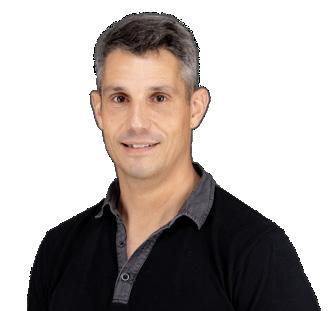
“Concrete lasts a long time,” Ferraro says. “What fails is the steel.”
Concrete and steel are used together to provide two kinds of strength. Concrete handles the compressive load, the weight of a structure. The steel takes care of the tensile load and allows for some flexibility. The combination of concrete and steel provide structural strength that’s hard to beat.
The ingredients in the recipe for
concrete are among the most common raw materials on Earth, Ferraro says. Cement is made of limestone, sand and clay. Concrete is made of cement, plus sand and gravel and water. That makes cement — Portland cement, in particular — a key focus of research.
In Ferraro’s lab, research focuses on nondestructive testing, uses of alternative binders and aggregates, infrastructure condition, and virtual testing and modeling of the concrete microstructure.
Traditionally, Portland cement is combined with a pozzolan, a material that has binding properties when combined with water. One of the most effective and common pozzolans is fly ash, which is a byproduct of coal-burning power plants. Coal fly ash also has the added benefit of recapturing a waste product of burning coal. Instead of releasing fly ash into the air or landfilling it, it is used to make concrete, and the addition of fly ash makes concrete more durable. As coal burning decreases, however, alternatives to fly ash will be in demand.
Some alternative pozzolans are crushed recycled glass and different types of clay. Sugar bagasse, a waste product of sugar cane farming, also is being studied thanks to South Florida’s large sugar cane crop. Ferraro is looking for alternative pozzolans that are structurally adequate, abundant, readily available and cost effective.
“We know that Portland cement on its own is less durable without fly ash, so we are looking for substitutes,” Ferraro says.
To read more, visit https://explore. research.ufl.edu/building-blocks.html




